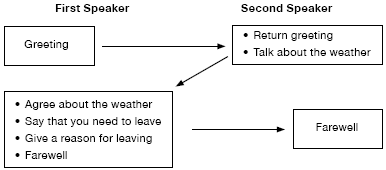Materials and equipment
Flip chart and markers
Preparation
You might want to prepare the following drawing ahead of time.
STEP-BY-STEP PROCESS
- Draw the following on the flip chart, or you may want to develop your own chain dialogue instead.
- Ask pairs of tutors to develop a dialogue based on the items you have written down. They will decide the scene (e.g., telephone call, walking by on the sidewalk). They need to put phrases or sentences down for each conversation point. For example, the first speaker could say “Hi. How are you?” for the greeting conversation point. The tutors do not have to use a box format, but they should indicate first and second speaker beside the sentences. You could also do this as a group.
- Have tutor pairs share their dialogues.
- Cover the following points:
- The variations in their dialogues are an example of the complexity of conversation.
- Suggest that simple dialogues like the one that they just wrote can be used to give learners a format to follow until they are ready for real conversation.
- These dialogues can be varied by, for example, substituting places, people, and other items in the conversation. Suggest a variation based on a tutor pair dialogue that you have just heard.
- The learner should move from the easier to the harder speaker’s parts.
- The dialogues don’t have to be memorized, but certain phrases and sentences will probably be important enough to memorize. Ask a few tutor pairs for an example of a phrase or sentence from their dialogue that would be important to memorize.
